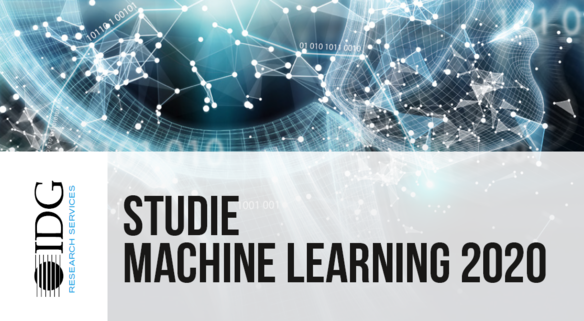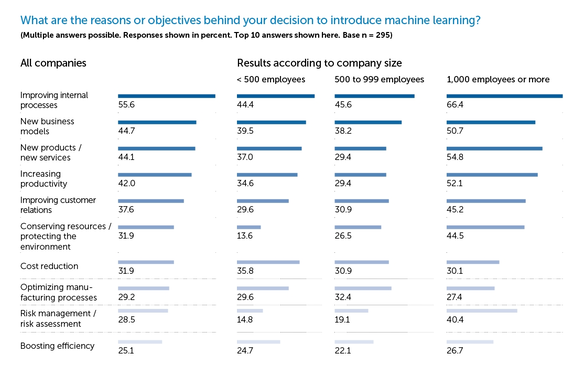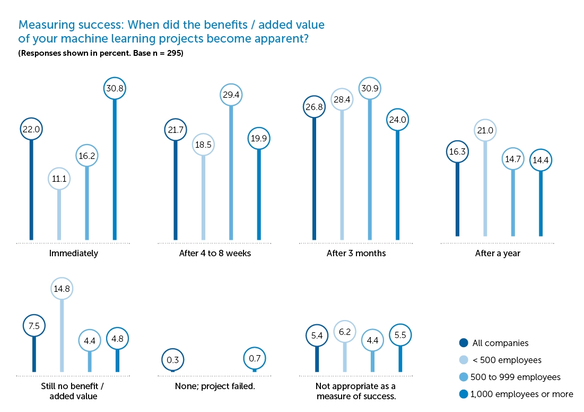Follow-up study for 2020: The new IDG Machine Learning Study 2020
German companies have made great strides in the field of machine learning (ML) and artificial intelligence (AI) over the last year. From industry and manufacturing to the energy supply sector and from transport and logistics to the health sector, ML has become established in almost every area of the economy. In this follow-up study to the IDG Machine Learning / Deep Learning Study 2019, companies of various sizes were once again asked for their assessment of ML and AI technologies.
Machine learning has arrived in many German companies
In the study conducted in 2020, three-quarters of respondents stated that their company already uses machine learning applications or is currently introducing them. This figure is around 20 percent more than last year and shows how the technology’s importance has grown since then. Moreover, AI/ML solutions appear to have reached a remarkable degree of maturity: Around 70 percent of those surveyed said they had identified a positive impact within a few months of introducing an ML solution.
However, the topic has still not penetrated all corporate levels to the same degree. While executive level has identified the business potential of machine learning, greater skepticism remains in IT departments and specialist divisions. This is shown in the fact that only 36 percent of specialists in IT and other fields see ML as an opportunity to develop new business models. Amongst C-level managers, however, this figure is around 60 percent. Therefore, although work is still required to convince some employees and assuage fears of KI/ML as a supposed job-killer, the general trend is positive.
Read the study to discover:
- Why companies are introducing machine learning and what they aim to achieve
- What AI/ML methods businesses are using
- An overview of the sources and types of data used for machine learning
- Information on how the outcome of the learning stage in the ML process is verified and which corporate area oversees this learning process
- Whether customers can be integrated in machine learning and AI projects – and, if so, at what stages
- Answers to how companies are measuring the success of their machine learning projects
The study was conducted in February 2020 by IDG Research Services and follows the investigation completed in 2019. In total, 406 companies in Germany participated in the survey, including businesses from different sectors, of different sizes and with varying annual turnovers. Lufthansa Industry Solutions was a partner to this study.
All key findings and outcomes are detailed in full in the study. The study is available for download (in German), free of charge. Some of the most important findings are listed below.
Machine learning and artificial intelligence drive innovation and optimization
Around 56 percent of the companies surveyed aim to improve their internal processes with the help of machine learning; among large enterprises, this figure is almost two-thirds. More than 44 percent regard the technology as the basis for new business models and offerings; for large-scale businesses, this figure rises to 51 percent (for business models) or 55 percent (for products). There is a risk that small and medium-sized enterprises will fail to tap the potential of these technologies. External consultants can remedy this issue and develop use cases with SMEs in order to make the technologies’ potential more tangible.
Voice recognition and image analysis dominate current AI and ML applications
The top four places in the rankings for AI and ML applications are taken by speech recognition (51 percent) followed by image recognition, text analysis and translation (all on 46 percent). However, the situation is different for large enterprises and SMEs. Large enterprises tend to focus on capturing large volumes of documents and use ML for facial recognition (52 percent), optical character recognition (or OCR; 56 percent) and in planning systems (54 percent). By contrast, small and medium-sized enterprises primarily regard machine learning as a tool to optimize their customer focus and customer service operations, using the technologies for behavior-based forecasting (32 percent) and target-group identification (31 percent).
Machine learning delivers demonstrable benefits
ML pays off – and the results of the latest survey back this up. Around 22 percent of ML projects yield immediate benefits; a further 22 percent deliver results after four to eight weeks. A further 27 percent of companies said they identified positive effects from ML solutions within three months, meaning that a majority see benefits within this period. In the context of IT projects, this is an astonishingly short time frame. Only eight percent of projects failed to deliver results.
Ease of use and transparency important factors in selecting an ML solution
The findings show that companies prioritize selection criteria for ML solutions has changed compared to last year, which reflects recent experience. While price was found to be the most important selection criterion in 2019, the latest survey discovered that companies now place greater importance on ease of use (40 percent overall, 47 percent for larger enterprises) and transparent operating principles in ML algorithms (40 percent overall, 45 percent for larger businesses).
To see the complete results of the survey in detail and find out more about the potential applications of AI and ML, download the free PDF of the Machine Learning Study 2020 (in German).




